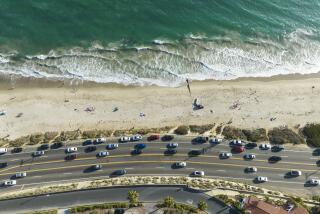Millions of Gallons of Raw Waste Spill Into Ocean Off Oahu After Sewer Line Ruptures
- Share via
HONOLULU — About 48 million gallons of raw sewage has gushed into the ocean off Oahu since a major sewer line ruptured last week, and it could take a month before bacteria levels at Waikiki beaches return to normal, city officials said Friday.
More than 100 warning signs to stay out of the water were posted along a 1 1/2 -mile stretch covering 18 beaches from Waikiki to downtown Honolulu.
The 42-inch main, installed in 1964, cracked after weeks of rain, and the sewage was diverted into the nearby Ala Wai Canal. Repairs were completed on the main Wednesday, but the effects linger.
“This spill is such a large magnitude. We have never seen this before,” said state Health Department spokesman Kurt Tsue. “It’s pretty bad.”
More heavy rain pounded the island Friday, triggering a smaller sewage spill, causing gridlock on the roadways, and flooding a mall and several homes.
Toys, food, chairs and other debris floated in brown murky water at Kahala Mall after floodwaters rushed through the shopping center’s theater complex. The water set off alarms and filled some of the 90 shops with more than a foot of brackish water.
The heavy rain also flooded a portion of the Moanalua Freeway and forced the closure of the Honolulu Zoo and city golf courses.
More than 36,000 gallons of partially treated wastewater spilled from the Waimanalo Wastewater Treatment Plant into a gulch that leads out to sea at Bellows Air Force Station.
The Honolulu mayor’s office said the ground was so saturated that the plant’s injection wells could not handle the inflow. Rain has been falling steadily in Hawaii since Feb. 19.
City crews put up signs in Japanese in front of beachfront hotels after some visitors from Japan were seen swimming in contaminated water.
Officials initially had not disclosed how much sewage had flowed into the Ala Wai Canal, giving only a broad estimate. On Thursday, Mayor Mufi Hannemann said that 48 million gallons had gone into the canal.
“The city had no other choice,” Hannemann said. “Had we not done that ... the negative impact from having homes, businesses, restaurants and hotels with wastewater backed into those areas would have been catastrophic.”
More to Read
Sign up for Essential California
The most important California stories and recommendations in your inbox every morning.
You may occasionally receive promotional content from the Los Angeles Times.













